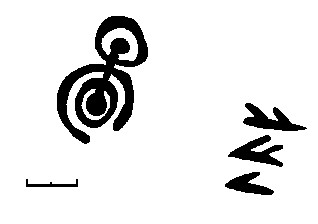Yorkshire Rock Art
Part 2 - The Lemmington wood rune stone.
Part 3 - Cupmarks in churchyards & Greystones.
Part 4 -Extracts from the journals of the Society of Antiquiries of Scotland (text only).
Part 5 - The Giants Lapstone
 The Lemmington Wood Rune Stone
The Lemmington Wood Rune Stone
Three weathered runes carved along side a Cup and ring motif, Lemmington wood, Northumberland.
Several thousand years may seperate the carving of these two sets of symbols and yet the association is intriguing, and perhaps its importance may have been overlooked.
The three runes can be interpreted in several ways :-
- L A F = remnant, relic, loaf (Old English)
- L Ae F = Laefen = leave, leave behind (Old English)
- L O F = Praise or Permission (Old Norse)
Individually each rune also has a name and meaning ......
- L (Lagu) = water, fertility.
- A (Ansuz /Aesc) = god - Odin, ash tree -Yggdrassil.
- F (Feoh) = Cattle, livestock (wealth).
A possible scenario ? :-
.............. An Anglo-saxon/Norse settler finds this cup and
ring carving on the land where they have settled, from their own
ancient tradition they have an understanding of the symbol, and
it seems appropriate to "recharge" the symbolism, so
they select 3 runes to carve along side it, runes which perhaps
convey the same idea as the cup and ring carving?
They select the runes for water/fertility, God(Odin?) and
Livestock, so creating a rune charm requesting their Gods
blessing to keep the livestock healthy and fertile?
A bit hard to imagine? ...... perhaps .......... yet over a thousand years after our imaginary Norse settler, farming families in Scotland still held similar beliefs regarding cattle, fertility, rock carvings and spirits! Up until the 1930's (and possibly to this day?) they were pouring milk onto cup marked stones as a spring time offering to faerie spirits to ensure that their cows would produce plenty of milk in the summer ! (see extracts in part 4)